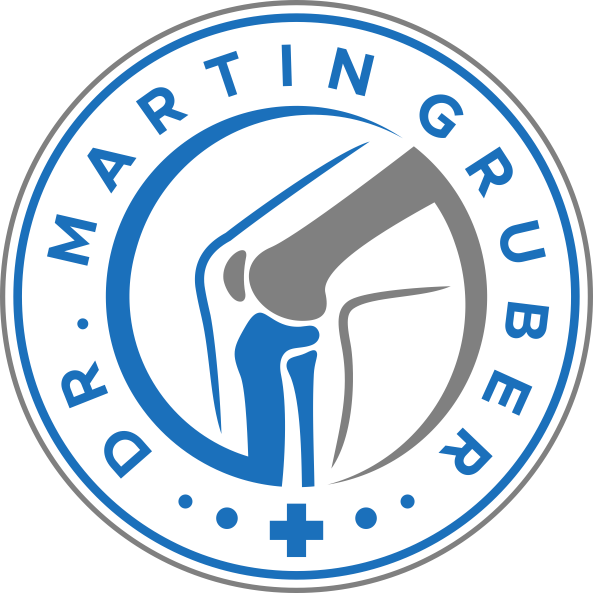Meniscus surgery
The meniscus is that part of the knee joint that is considered a secondary stabilizer. There are two pieces of these crescent-shaped, cartilaginous shock absorbers in the knee joint, one on the inside and one on the outside. They are located between the upper and lower leg, more precisely between the articular surfaces of these bones. If knee joint pain occurs, in most cases the meniscus is responsible because of wear, damage or injury to it. (Meniscal injuries are the most common type of injury to the knee).

Whereas in the past entire menisci were surgically removed, today people are aware of its indispensability and try to operate as gently as possible while preserving the healthy meniscal tissue. Nowadays, modern imaging allows an accurate diagnosis as soon as someone is affected by knee pain or problems in this area and everything points to the meniscus as the cause. Fortunately, interventions on the meniscus can now be performed arthroscopically, which is why open surgery or the opening of the knee joint is not (no longer) necessary.
What is arthroscopy and how does it work?
Arthroscopy is a minimally invasive procedure. The so-called keyhole surgery requires only small skin incisions through which a thin optic is inserted into the knee joint to mirror it and thus transfer its inner workings to a screen. This allows the surgeon to take a close look at all damage and problems and repair them. Depending on the condition and diagnosis, the damaged part of the meniscus is removed or it is sutured, provided the tear is close to the capsule and in an area with good blood supply.
Arthroscopy is now considered state of the art in meniscal surgery and is not only associated with a low risk of infection for patients, but is also associated with less postoperative pain as well as faster recovery. Pain and irritation as well as limited flexibility of the joint due to the damaged shock absorber are a thing of the past after arthroscopy. The goal of preserving the meniscus as much as possible and solving the problem in the course of surgery, but by no means removing it extensively or completely, is achievable in most cases thanks to this technique. Consequential damage such as osteoarthritis can thus be prevented or delayed. It is important to act as early and individually adapted as possible, whereby age, life circumstances (e.g. sporting activity) and existing pathology play a major role.
Advantages of arthroscopy
- Precise surgery without large skin incisions
- Faster regeneration
- Maximum gentle and structure-preserving
- Complete overview of the situation in the knee joint or also of areas that are not visible from the outside
Forms of treatment and procedures
Partial meniscus resection
During arthroscopic visualization of the joint and the impaired meniscus, the surgeon can obtain a comprehensive picture of the damage (resection form, extent of resection) and test the stability of the meniscus – including and especially in the area of the tear – and its surrounding structures using appropriate instruments. The damaged meniscus area is then removed, leaving as stable and functional a residual meniscus as possible, so that after the operation has been performed, the patient can continue to live normally and without restrictions and, if necessary, participate in sports normally.
Meniscus suture or meniscus crefixation
Provided that the meniscus is “only” torn and hardly worn, it can be repaired by means of meniscus suture. This is a tissue-sparing procedure because it does not require cartilage removal. If the inside-out technique is used, the surgeon guides a needle and thread under arthroscopic view through the meniscus inside the joint to the outside (vice versa, i.e. from the outside to the inside, is called the outside-in technique) and ties it in front of the joint capsule or outside the knee joint. The all-inside technique , in turn, involves placing two anchors in front of the joint capsule to allow for the tightening of a knot. This modern technique requires no additional skin incisions and provides a solution within the joint capsule. The intra-articular suture used in this process refers to structures located within the joint capsule of a joint. Threads and anchors dissolve by themselves after some time.
If indirect suturing is indicated, the ends of the tear are microsurgery. You puncture or score the meniscal tissue to create minimal wounds that are accompanied by bleeding and stimulation of the body’s own wound healing. This treatment method, called needling, is also used in aesthetic surgery against wrinkles or scars. In knee surgery, it can be used if the meniscus tear is located in the internal perfused area, the so-called red zone.
If a meniscus root lesion occurs, it results in a loss of mechanical suspension of the posterior horn or anterior horn, which in the case of the lateral meniscus are connected to the tibia. This requires surgical fixation of the torn meniscus or torn meniscus root by means of transosseous sutures, i.e. sutures pulled through the bone by means of a drill channel – usually on the lower leg, since the meniscus roots tear off most frequently there. Transosseous refixation of the meniscus root (= root repair) is an effective form of pain relief and ensures restoration of function.
